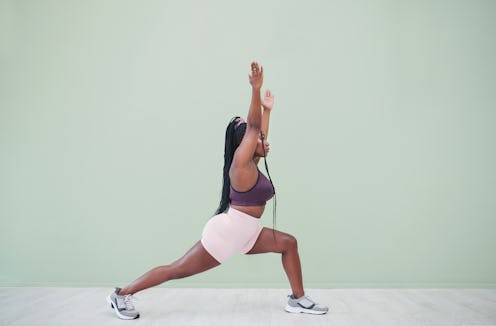Fitness
Get ready to squat and crawl.
Think squats, lunges, and twists.
They cover all your bases, which is why theyre considered thefoundation of functional fitness, Lenau tells Bustle.

So youll have better mobility and a stronger mind-body connection, which aids in every movement that you do.
Primal movementsdont require any equipment, Lenau adds, so theyre easy to do wherever you are.
Here, trainers share 10 examples of primal movement exercises thatll help get you started.
One such example is the inchworm or walkout.
This is a bodyweight exercise that targets the core, shoulders, and legs, he tells Bustle.
Heres how to do it.
Stand with your feet shoulder-width apart.
Bend over at the waist.
Place your hands on the floor in front of you, keeping your legs straight.
Walk your hands out while maintaining a straight line from hands to feet.
When your body forms a straight line, pause for a moment.
Walk your feet towards your hands.
Keep your hands on the floor.
Once your feet reach your hands, stand up to the starting position.
Itll also improve your mobility and stability.
Start on all fours in a tabletop position.
Lift your knees off the ground.
Move one hand and your opposite foot forward to take a step.
Alternate sides as you continue to crawl.
Repeat for 30 seconds to two minutes at a time.
Aim for 2 to 4 sets.
3Jump Squat
Frayna recommends doing jump squats to work your glutes, core, and hips.
As aplyometricmove, they also provide a boost in cardio.
Stand with your feet hip-width apart.
Jump straight up.
Swing your arms up for momentum.
Land on slightly bent knees.
Squat down and repeat.
Jump for 1 minute.
Its also afunctional movement patternthat helps you bend and twist with ease.
Sit on the floor with your legs out in front of you.
Keep a slight bend in your knees.
Lean back to engage your core.
Twist your torso/arms from side to side.
For a challenge, lift your feet up.
Do 3 sets of 20 to 30 twists.
5Deadlift
Another exercise that mimics thefunctional movement patternsfrom everyday life is thedeadlift, saysDr.
Dave Candy, PT, DPT, a doctor of physical therapy and owner ofMore 4 Life.
Here is how to do it.
Stand behind a lighter barbell, set of dumbbells, or kettlebell.
Step your feet as close to the weight as possible.
Push your hips backwards and allow your knees to slightly bend.
Grab the weight and lift it to waist level.
Drive your heels into the floor and squeeze your glutes.
Push your hips forward.
Keep your abs engaged.
Lower the weight back down.
Lunge one leg forward.
Transfer your weight to your front leg.
Bend both knees 90 degrees.
Align your front knee over your second toe.
Hover your back knee just above the floor.
Push off from your front leg and bring it back to your original stance.
Alternate legs and repeat.
For a challenge, hold a dumbbell in each hand.
Take a step forward with one leg.
Lower your hips until your front knee and back knee are bent 90 degrees.
Gently touch your back knee to the ground.
Straighten your back leg.
Continue walking and repeating the movement.
Lunge for 2 minutes and repeat 2 to 3 times.
Its also a good go-to forbetter posture.
Lie face-down on the floor with your arms and legs out straight.
Keep your neck neutral.
Engage your torso and glutes.
Lift your arms and legs a few inches off the ground.
To modify, just lift your arms.
Hold for a few seconds.
Lower your hips as if sitting back in a chair.
Keep your chest up and your weight in your heels.
Push into your heels to raise back up.
Engage your glutes.
Start in a plank position with your legs extend behind you.
Place your hands shoulder-width apart.
To modify, keep your knees on the ground.
Lower your body until your chest almost touches the ground.
Keep your core engaged.
Press into your hands to raise back up.
Studies referenced:
Hefzy, MS. (1997).Co-activation of the hamstrings and quadriceps during the lunge exercise.